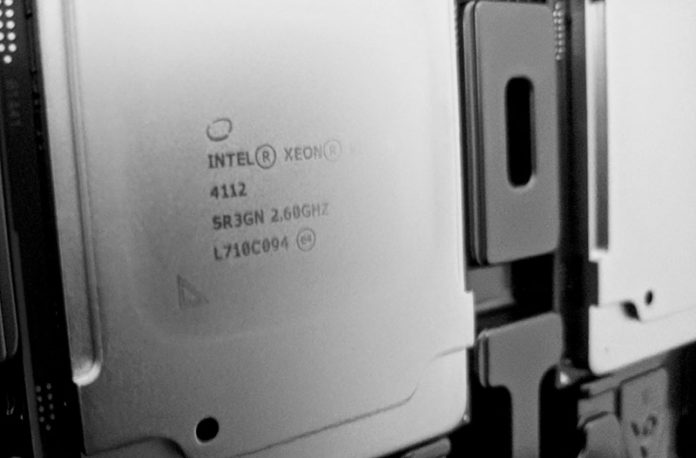Today we are reviewing the lowest performance Intel Xeon Silver SKU, in a dual socket configuration. Providing a total of 8 cores and 16 threads across both CPUs, the dual Intel Xeon Silver 4112 is one of the lowest power dual CPU configurations we have tested in this generation. We have had some time with the chips and wanted to provide a perspective on the performance characteristics so that those who are contemplating a purchase between a dual processor Silver 4112 and other options in the market can have hard data to use in their decision-making process.
The Intel Xeon Silver 4112 is one of the more intriguing parts. It is a low core count Intel Xeon Silver which means it is one of only three quad core, eight thread CPUs in the launch Intel Xeon Scalable processor lineup. Unlike the Intel Xeon Gold 5122 it does not have high clock speeds. What it does carry is 2.0625 MB L3 cache per core in addition to the 1MB per core L2 cache. Price wise, this chip retails for just under $475 putting it between the Silver 4108 ($410) and Silver 4110 ($500) which are 8 core, 16 thread chips in this generation.
Key stats for the Intel Xeon Silver 4112: 4 cores / 8 threads, 2.6GHz base and 3.0GHz turbo with 8.25MB L3 cache. The CPU features an 85W TDP. Here is the ARK page with the feature set. The dual processor configuration we are testing today is simply two of these CPUs as you can see from the lscpu output:
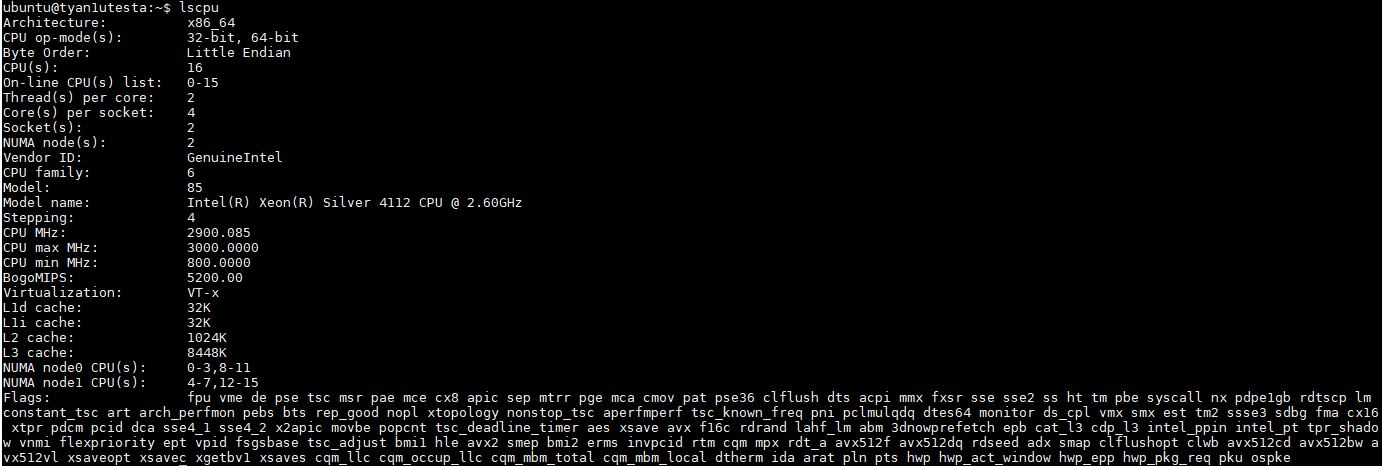
If you want to read more about the single socket performance, see our previously published Intel Xeon Silver 4112 Linux Benchmarks and Review.
Test Configuration
For this CPU review, we are using a 1U Tyan Thunder CX GT75BB7102 test platform.
- CPUs: 2x Intel Xeon Silver 4112
- System: Tyan Thunder CX GT75BB7102 1U
- RAM: 12x 16GB DDR4-2400 ECC RDIMM (Micron)
- NIC: Mellanox ConnectX-3 EN Pro 40GbE
- OS SSD: Intel DC S3700 400GB
The Tyan Thunder CX GT75BB7102 is a dual socket server that crams a surprising amount of functionality into a 1U chassis. One can put a full complement of 24x DDR4 RDIMMs along with two PCIe x16 cards, multiple OCP mezzanine cards (storage and networking) as well as use M.2 SSDs.
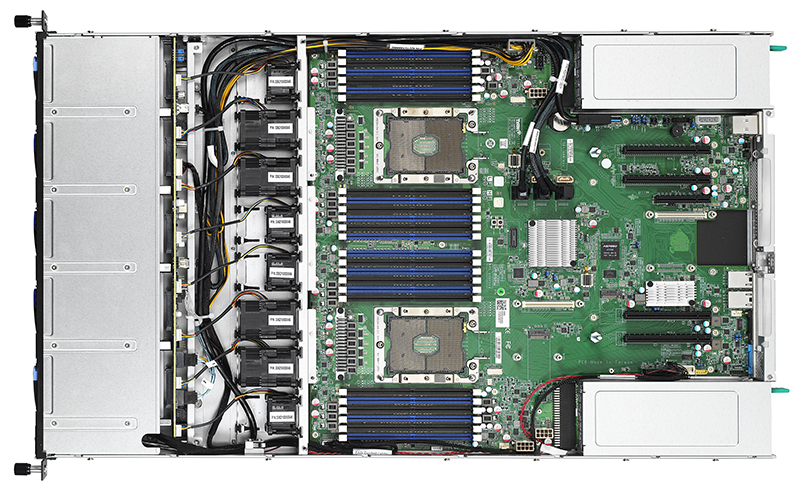
Redundant PSUs flank each side of the motherboard, and Tyan uses a novel array of fans which combine to channel cold air over the parts of the server that need it most.
In terms of storage, along with the PCIe based options, there are 10x storage bays in the front. In our test system, we are using the Intel C621 PCH SATA lanes for a low power setup. One can also use SATA DOMs on the two standard 7-pin SATA connectors.

This configuration also comes with some nice features, for example, the RJ-45 networking ports on the back of the server are 10Gbase-T Ethernet.

Overall, this is a nice platform for low power servers.
Dual Intel Xeon 4112 Benchmarks
For this exercise, we are using our legacy Linux-Bench scripts which help us see cross-platform “least common denominator” results we have been using for years as well as several results from our updated Linux-Bench2 scripts. At this point, our benchmarking sessions take days to run and we are generating well over a thousand data points. We are also running workloads for software companies that want to see how their software works on the latest hardware. As a result, this is a small sample of the data we are collecting and can share publicly. Our position is always that we are happy to provide some free data but we also have services to let companies run their own workloads in our lab, such as with our DemoEval service. What we do provide is an extremely controlled environment where we know every step is exactly the same and each run is done in a real-world data center, not a test bench.
Python Linux 4.4.2 Kernel Compile Benchmark
This is one of the most requested benchmarks for STH over the past few years. The task was simple, we have a standard configuration file, the Linux 4.4.2 kernel from kernel.org, and make the standard auto-generated configuration utilizing every thread in the system. We are expressing results in terms of compiles per hour to make the results easier to read.
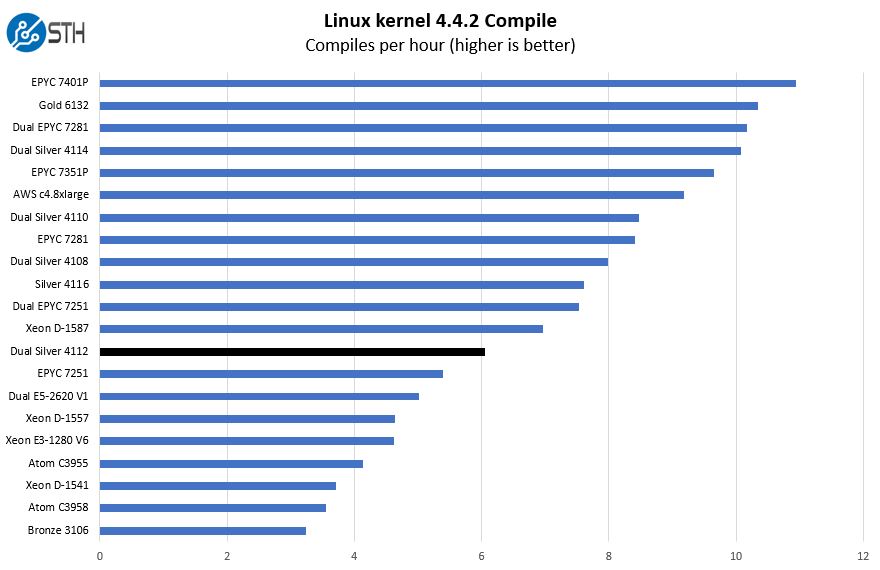
Here we can see solid performance. Compared to the Intel Xeon D line, the dual processor Xeon Silver 4112 has higher clock speeds, more memory bandwidth, and caches which help it compete here.
c-ray 1.1 Performance
We have been using c-ray for our performance testing for years now. It is a ray tracing benchmark that is extremely popular to show differences in processors under multi-threaded workloads. We are going to use both our legacy 4K result along with our new Linux-Bench2 8K render to show differences.
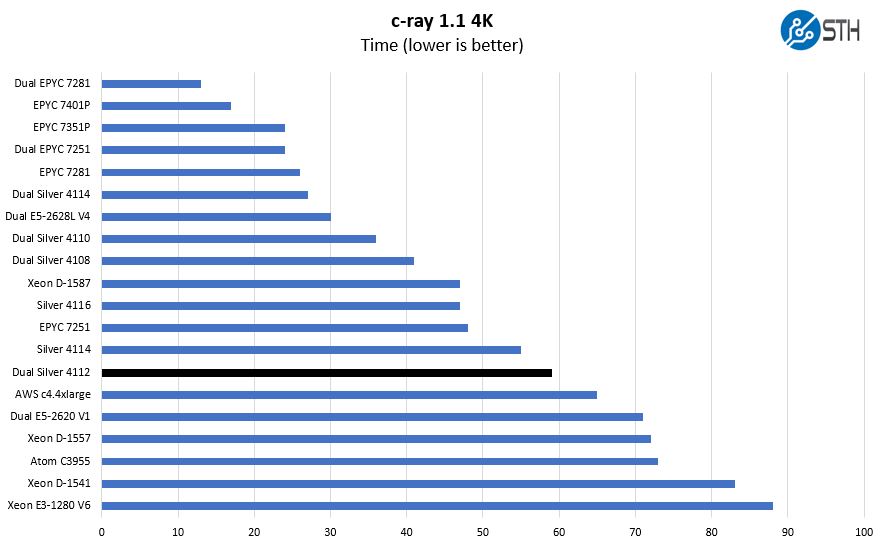
AMD EPYC performs extremely well here. At the same time, we see the dual Intel Xeon Silver 4112 easily outpace a Sandy Bridge generation dual Intel Xeon E5-2620 V1 setup.
7-zip Compression Performance
7-zip is a widely used compression/ decompression program that works cross-platform. We started using the program during our early days with Windows testing. It is now part of Linux-Bench.
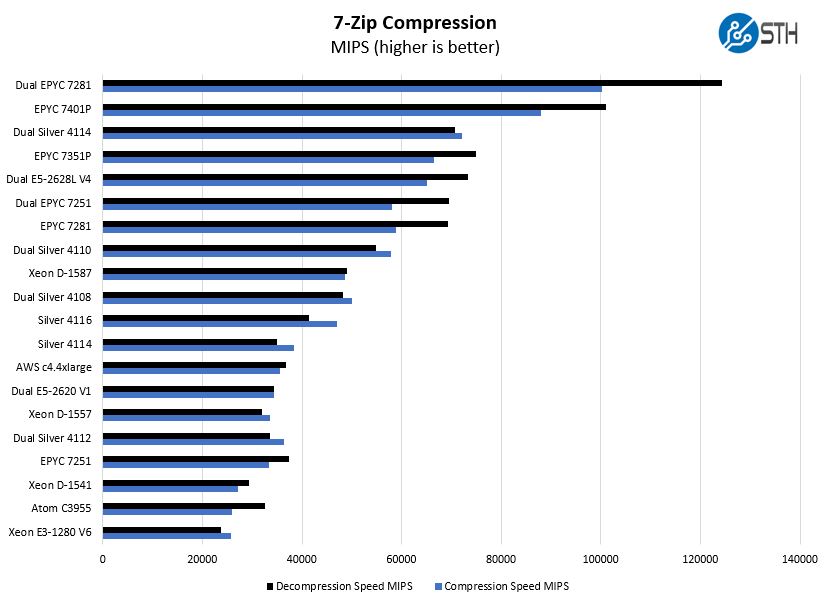
This is sorted by compression speed while the Intel Xeon Scalable CPUs tend to look better sorted by the decompression side. Still, we can see the performance that is just below a single Intel Xeon Silver 4114 as we are crossing NUMA nodes instead of staying completely on one CPU. That can make a large difference in this segment.
NAMD Performance
NAMD is a molecular modeling benchmark developed by the Theoretical and Computational Biophysics Group in the Beckman Institute for Advanced Science and Technology at the University of Illinois at Urbana-Champaign. More information on the benchmark can be found here. We are going to augment this with GROMACS in the next-generation Linux-Bench in the near future. With GROMACS we have been working hard to support Intel’s Skylake AVX-512 and AVX2 supporting AMD Zen architecture. Here are the comparison results for the legacy data set:
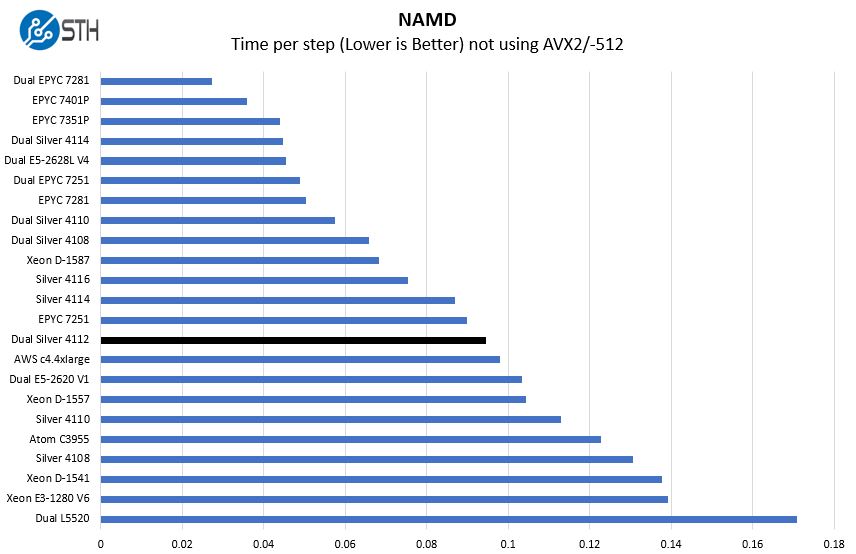
Our NAMD results put the 2P Intel Xeon Silver 4112 setup just behind the AMD EPYC 7251, however one can easily see that the configurations are trading blows on each benchmark.
Sysbench CPU test
Sysbench is another one of those widely used Linux benchmarks. We specifically are using the CPU test, not the OLTP test that we use for some storage testing.
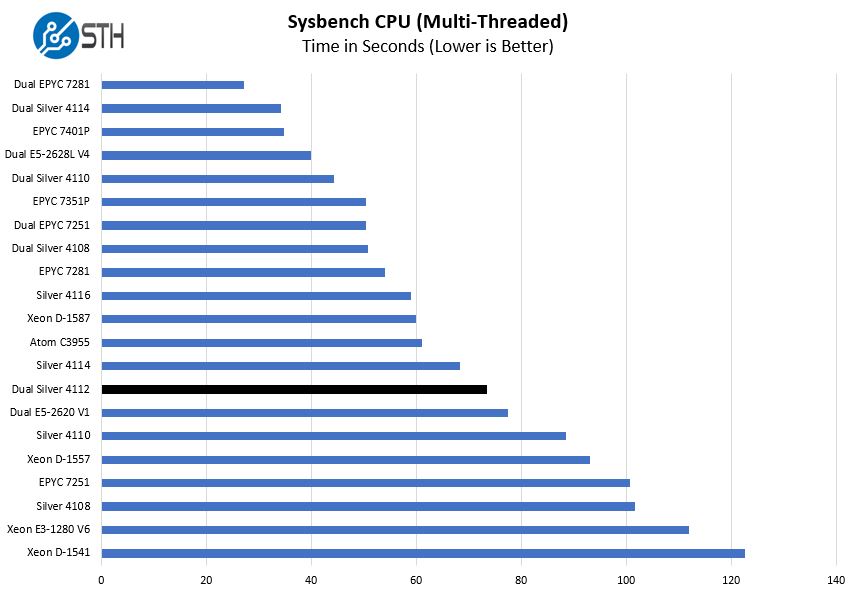
One area that we wanted to point out here is that we see a benefit from the two CPUs each having higher turbo speeds than their 8 core counterparts. As a result, the dual Intel Xeon Silver 4112 configuration is noticeably faster than getting 8 cores from a single Silver 4110.
OpenSSL Performance
OpenSSL is widely used to secure communications between servers. This is an important protocol in many server stacks. We first look at our sign tests:
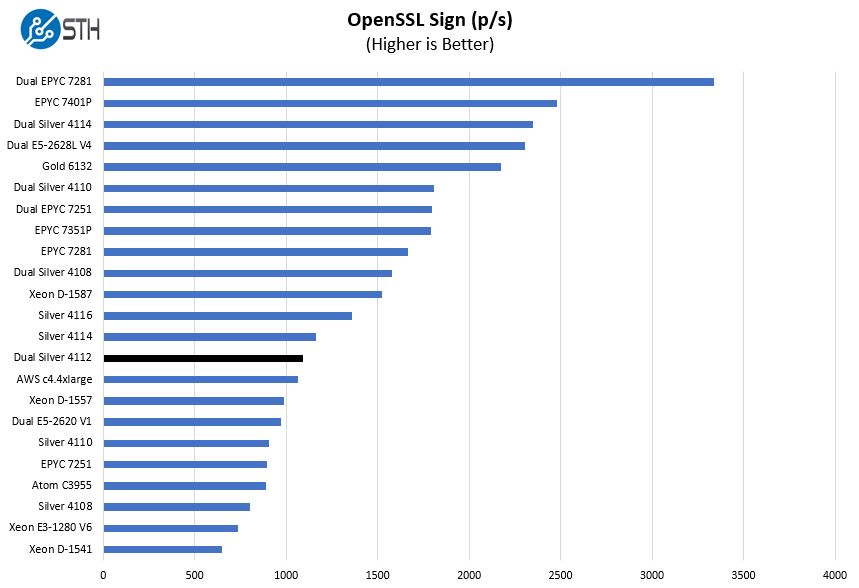
And the verify results:

Again, two CPUs with higher clock speeds allow the setup to outpace a single Silver CPU with 8 cores, albeit at a much higher cost.
UnixBench Dhrystone 2 and Whetstone Benchmarks
Some of the longest-running tests at STH are the venerable UnixBench 5.1.3 Dhrystone 2 and Whetstone results. They are certainly aging, however, we constantly get requests for them, and many angry notes when we leave them out. UnixBench is widely used so we are including it in this data set. Here are the Dhrystone 2 results:
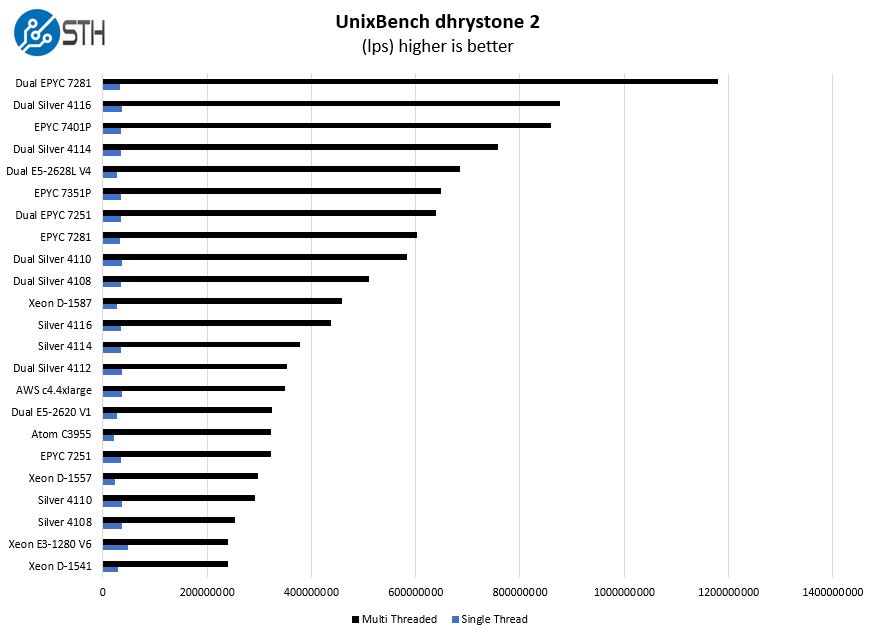
And the whetstone results:
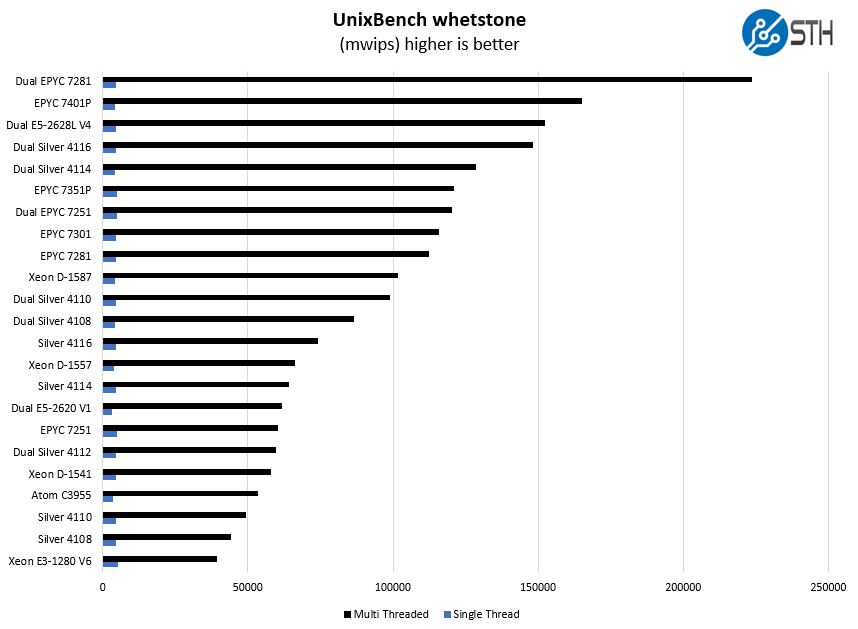
Those are solid figures. Based on the scale it is hard to see the single-threaded performance. Each of the Intel Xeon Silver chips has a maximum turbo of 3.0GHz so they all end up in a virtual dead heat in terms of single-threaded performance. Multi-threaded is where we see some separation.
GROMACS STH Small AVX2/ AVX-512 Enabled
We have a small GROMACS molecule simulation we previewed in the first AMD EPYC 7601 Linux benchmarks piece. In Linux-Bench2 we are using a “small” test for single and dual socket capable machines. Our medium test is more appropriate for higher-end dual and quad socket machines. Our GROMACS test will use the AVX-512 and AVX2 extensions if available.
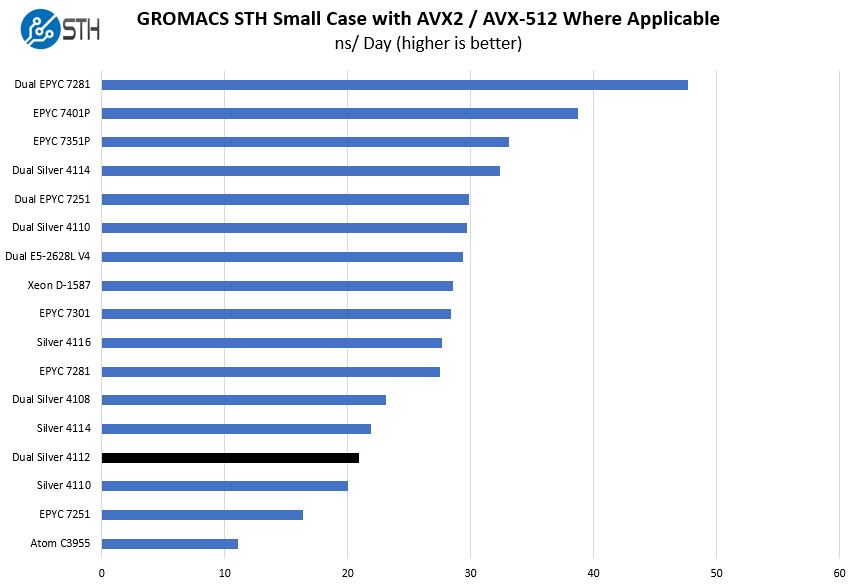
Given the price/ targeting, we do not have the Intel Xeon Gold 6100 series on this chart. Suffice to say, one can get performance that would change the scale of this chart using even the 8 core Intel Xeon Gold 6134. The Intel Xeon Silver line does not have the dual FMA AVX-512 so AMD EPYC is extremely competitive even though it is still using AVX2.
Chess Benchmarking
Chess is an interesting use case since it has almost unlimited complexity. Over the years, we have received a number of requests to bring back chess benchmarking. We have been profiling systems and are ready to start sharing results:
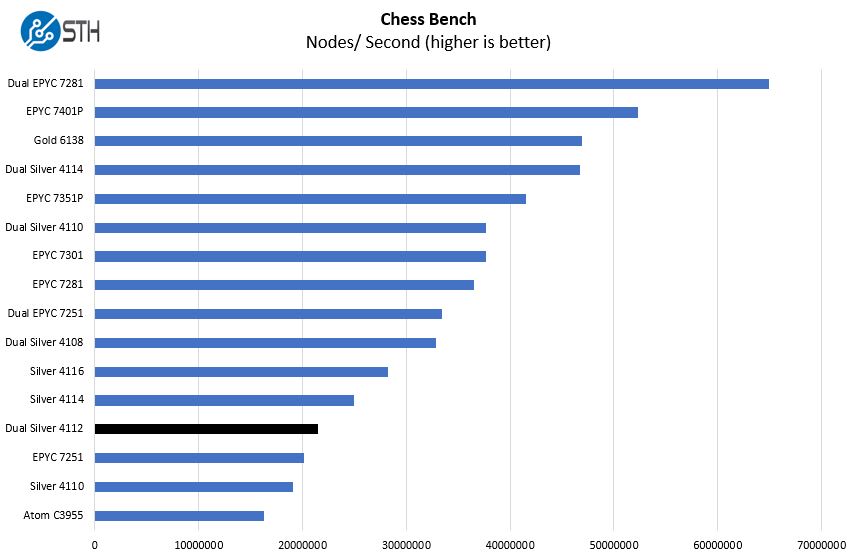
In terms of chess benchmarking, we see a nice uplift over the AMD EPYC 7251 CPUs in the test. We also see better than a single 8-core performance due to higher turbo clocks. At the same time, in the same price range, the dual Intel Xeon Silver 4110 shows significantly more performance for essentially the same cost.
A Note on Power Consumption
We wanted to post a few figures from our testing that show the real selling point of the chips, low power.
- Idle: 69W
- 70% Load: 144W
- 100% Load: 185W
- Peak: 191W
Note these results were taken using a 208V Schneider Electric / APC PDU at 17.8C and 72% RH. Our testing window shown here had a +/- 0.3C and +/- 2% RH variance. These are great power consumption figures. These are certainly solid results for this system and a large amount of the power is not used by the CPU and instead by the RAM and peripherals.
Market Positioning
Thes chips are not released in a vacuum instead, they have competition on both the Intel and AMD sides. When you purchase a server and select a CPU, it is important to see value of a platform versus its competitors.
2P Intel Xeon Silver 4112 v. Intel Xeon
In the world of Intel Xeon Silver, the dual socket 4108 and 4110 would be our recommendations in the vast majority of scenarios. Only if you are constrained to having at most 4 cores per socket due to licensing costs would we recommend the Intel Xeon Silver 4112. That recommendation comes with a severe caveat, Intel has many chips that have higher performance with low core counts such as the Gold 5122.
This is a niche chip in the line and one that should have gotten a model number of Silver 4107 instead of 4112 to avoid confusion.
2P Intel Xeon Silver 4112 v. AMD EPYC
On the AMD EPYC competition side, essentially a dual socket Intel 4112 is most competitive with a single socket AMD EPYC 7251, the lowest-end AMD EPYC CPU. If we were looking at pure CPU pricing, the dual Xeon Silver 4112 with a combined total of 8 cores would be priced close to a 24 core AMD EPYC 7401P which provides an enormous amount of additional performance for about $100 more while providing slightly fewer DDR4 DIMM slots and potentially more PCIe lanes. The single socket AMD EPYC 7401P setup will use more power than the dual socket Intel Xeon Silver 4112 so TCO costs on the AMD side will be higher. If you are looking for performance, AMD’s consolidation ratios will offer better TCO.
Final Words
From a performance perspective, it is hard for us to recommend the dual Intel Xeon Silver 4112 over the other Intel Xeon Silver CPUs. On the other hand, if you simply need a low power dual socket server, and a minimal number of cores for a licensing nuance corner case, we can see a scenario where the dual Intel Xeon Silver 4112 setup makes sense. On the other hand, if you do not have licensing constraints, we would highly recommend getting either a dual Intel Xeon Silver 4108 or dual Intel Xeon Silver 4110 setup instead. Both have twice as many cores. The Silver 4110 costs negligibly more yet has higher clock speeds than the Silver 4108.

